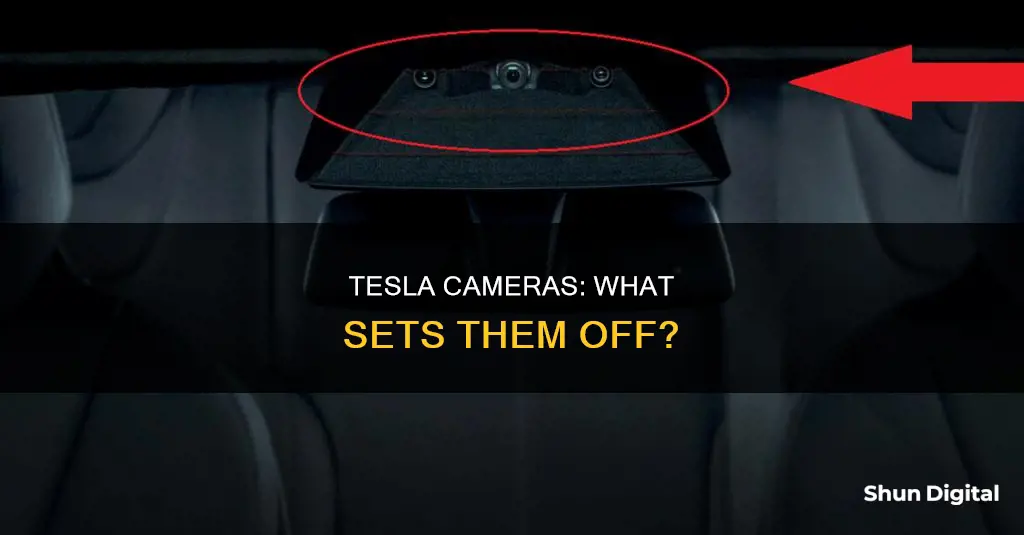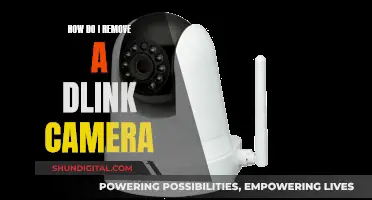
Tesla's camera systems are designed to enhance safety, enable autonomous features, and provide security against threats. The cameras are strategically placed around the vehicle and are active every time the vehicle is in motion. They also record when the vehicle is parked, and can be triggered by suspicious motion or activity. This includes jerky movements, such as when the vehicle is being towed or shaken, as well as attempts to gain unauthorised access to the vehicle. The cameras can also be manually triggered by the driver through voice commands or the Tesla app. While the primary use of the cameras is for the Autopilot system and active safety features, they also have secondary functions, such as recording potential threats when the vehicle is parked and monitoring driver attentiveness.
| Characteristics | Values |
|---|---|
| Number of Cameras | 8 or 9, depending on the model |
| Camera Locations | Rear license plate, door pillars, windshield, front fenders, rearview mirror, bumpers |
| Camera Functions | Security, safety, driver assistance, autonomous features |
| Recording Triggers | Suspicious motion, security threats, accidents, incidents |
| Recording Parameters | Visual and audio, 360-degree vision, all angles |
| Recording Duration | 10-minute clips, overwritten if not saved |
| User Access | Tesla app, Tesla website, vehicle touchscreen |
| User Settings | Enable/disable recording features, adjust notification preferences |
| User Concerns | Privacy, data sharing, lack of warnings for distracted drivers |
What You'll Learn
- Cameras monitor driver attentiveness and provide alerts to keep their eyes on the road
- Tesla's Autopilot system uses cameras to record video of the vehicle's surroundings
- The cabin camera does not perform facial recognition or any other method of identifying the driver
- The rearview camera assists with parking, reverse driving, and automatic emergency braking
- The front cameras include a telephoto lens, a wide-angle lens, and a typical lens

Cameras monitor driver attentiveness and provide alerts to keep their eyes on the road
Tesla vehicles have several security features that are designed to enhance safety, enable autonomous features, and provide security against threats. One of these features is the cabin camera, which is located above the rear-view mirror in the Model S (produced in 2021 or later) and Model X (produced in 2021 or later). The cabin camera can determine driver inattentiveness and provide audible alerts to remind the driver to keep their eyes on the road when Autopilot is engaged. This feature helps to ensure safety during Autopilot use and can be viewed onscreen by navigating to Controls > Service > Preview Cabin Camera.
The cabin camera does not perform facial recognition or any other method of identifying or verifying identity. Images and video from the cabin camera remain within the vehicle itself and are not transmitted to anyone, including Tesla, unless the driver chooses to enable data sharing. If data sharing is enabled, the vehicle can share images and short video clips with Tesla in the occurrence of a serious safety risk or a safety event, such as a collision, to help develop future safety features and software enhancements. Drivers can adjust their data sharing preferences by tapping Controls > Software > Data Sharing > 'Allow Cabin Camera Analytics'.
It is important to note that Tesla takes data privacy seriously. For the cabin camera, data is not saved or transmitted unless data sharing is enabled in the car's settings. For other features like Sentry Mode and Dashcam, data is stored locally and can only be accessed by the owner.
In addition to the cabin camera, Tesla vehicles have several other cameras strategically placed around the vehicle. These include front-facing cameras, a rearview camera, fender cameras, and side cameras on the B-pillar. These cameras have a variety of functions, such as assisting with parking, monitoring blind spots, and enabling autonomous features like Autopilot and Automatic Emergency Braking.
Uncover Hidden Cameras: Sweep Your Room for Spy Tech
You may want to see also

Tesla's Autopilot system uses cameras to record video of the vehicle's surroundings
The Autopilot system includes cameras mounted on different parts of the vehicle, such as above the rear license plate, on the door pillars, the windshield, and the front fenders. These cameras have various functions, such as monitoring the vehicle's blind spots, assisting with parking and reverse driving, and providing a panoramic view for navigation at complex intersections.
The Autopilot system also includes a cabin camera located above the rear-view mirror, which monitors driver attentiveness and provides audible alerts to remind the driver to keep their eyes on the road when Autopilot is engaged. This camera does not perform facial recognition and only captures images of the entire cabin, ensuring that data privacy is maintained.
In addition to the safety features, the Autopilot system's cameras are also utilised for security purposes through the Sentry Mode. When enabled, the cameras remain powered on and ready to record suspicious activity or potential threats when the vehicle is locked and parked. The system alerts the owner through the mobile app and saves footage of the event to a USB drive if installed.
Tesla is continuously improving its camera systems, with future models expected to include a bumper camera and higher-resolution cameras with an anti-glare coating for enhanced visibility. The advanced camera systems play a crucial role in enhancing vehicle safety and providing driver-assist features, contributing to Tesla's mission of shaping the future of sustainable transportation.
Unlinking Your Camera from Your Smart TV
You may want to see also

The cabin camera does not perform facial recognition or any other method of identifying the driver
Tesla vehicles have several security features that can be activated through the touchscreen. One such feature is the cabin camera, which is located above the rear-view mirror in Model S and Model X vehicles produced in 2021 or later. The cabin camera can determine driver inattentiveness and provide audible alerts to remind the driver to keep their eyes on the road when Autopilot is engaged.
While the cabin camera can capture images of passengers, it does not perform facial recognition or any other method of identifying the driver or verifying identity. The camera data is processed directly on the vehicle itself and is not transmitted to anyone, including Tesla, unless data sharing is enabled and a safety event occurs. In this case, the vehicle can share images and short video clips with Tesla to help develop future safety features and software enhancements. However, these images are not linked to the vehicle identification number (VIN) and can be disabled by the user at any time.
Tesla has also revealed plans to use facial recognition in the future to offer new 'Driver' and 'Passenger' profiles. This technology would allow the vehicle to set the driver's profile based on who is in the driver's seat and offer passenger profiles that take into account seat position, seat heater, climate temperature, and air vent direction. However, as of 2024, this feature has not yet been implemented.
Understanding Camera Settings: TV or Shutter Speed Priority
You may want to see also

The rearview camera assists with parking, reverse driving, and automatic emergency braking
The rearview camera is an integral part of the Tesla Autopilot system and its active safety features. Positioned above the license plate, it provides a view of up to 50 meters behind the vehicle, offering valuable assistance in several scenarios.
Firstly, the rearview camera aids with parking by alerting the driver of any objects in close proximity to the vehicle. When driving slowly, the vehicle uses its cameras to detect objects and notify the driver, helping to prevent collisions. This is particularly useful when performing complex manoeuvres, such as parallel parking.
Secondly, the camera assists with reverse driving by providing a clear view of the area behind the vehicle. This is especially beneficial when backing out of a driveway or parking spot, ensuring the driver is aware of any potential obstacles or hazards.
Lastly, the rearview camera plays a crucial role in automatic emergency braking. When a collision is considered unavoidable, the Automatic Emergency Braking (AEB) system engages, applying the brakes to reduce the vehicle's speed and mitigate the severity of the impact. The rearview camera, with its view of the area behind the vehicle, is instrumental in triggering this safety feature. The AEB system operates when driving forward or in reverse, and its effectiveness relies on clear and unobstructed cameras.
To ensure optimal performance of the rearview camera, it is essential to keep it clean and free of obstructions. Regular maintenance, such as cleaning the camera lens, is recommended to maintain the camera's functionality and enable it to effectively support the various driving scenarios mentioned.
Finding the Camera on Your Vizio Smart TV
You may want to see also

The front cameras include a telephoto lens, a wide-angle lens, and a typical lens
Tesla vehicles have several security features that can be activated from the touchscreen. These include Sentry Mode, which uses cameras and sensors to monitor the vehicle's surroundings when it is locked and parked. In the event of suspicious activity, the cameras will begin recording, and the alarm will be triggered. The owner will receive an alert via the Tesla app, and footage of the event will be saved to a USB drive.
The front cameras on a Tesla Model Y include a telephoto lens, a wide-angle lens, and a typical lens. The telephoto lens has a longer focal length than a normal lens, allowing for a shorter focal length than the physical length of the lens. This is achieved by incorporating a telephoto group that extends the light path to create a longer focus in a shorter design. The wide-angle lens, on the other hand, has a shorter focal length, allowing it to capture a wider field of view. The third, typical lens, likely serves as a standard lens for everyday use, with a focal length between 35mm and 80mm.
The combination of these three lenses provides the Tesla with a versatile range of focal lengths, enabling it to capture a wide field of view and zoom in on distant objects. The telephoto lens is ideal for bringing distant scenes closer, while the wide-angle lens is perfect for capturing more of the surrounding environment. The standard lens provides a balanced perspective for everyday use.
It is important to note that the specific functionality and performance of these lenses may vary depending on the Tesla model and software version.
Candid Camera: Best Places to Watch the Show
You may want to see also
Frequently asked questions
Tesla cameras are active whenever the vehicle is in motion and when it is parked. The cameras record when you park the vehicle, and the vehicle's computer system sends you a notification through a message or email if someone tries to access or damage your vehicle.
Yes, Tesla dash cams record accidents and can be used to help drivers plead their side in court.
Yes, Tesla vehicles record both video and audio at all times when they are in motion.
Yes, the Sentry Mode feature allows the vehicle to record any suspicious activity when it is parked and turned off.







